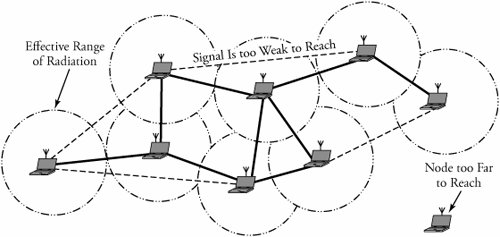Section 19.1. Overview of Wireless Ad-Hoc Networks
19.1. Overview of Wireless Ad-Hoc NetworksWireless mobile ad-hoc network (MANET) technology is designed for the establishment of a network anywhere and anytime , without any fixed infrastructure to support the mobility of the users in the network. In other words, a wireless ad-hoc network is a collection of mobile nodes with a dynamic network infrastructure forming a temporary network. Such networks no central server or base station for providing connectivity, and all network intelligence must be placed inside the mobile user devices. Figure 19.1 gives overview of an ad-hoc network, where wireless mobile nodes have formed a network, with one node too far to reach. Figure 19.1. Overview of an ad-hoc network In such an environment, each mobile user acts as a routing node, and a packet is routed from a source to its destination by incorporating of other network users. Since the topology of an ad-hoc network can change quickly and unpredictably, it should be adaptable to changes, such as when a link breaks, a node leaves the network, or a new node is attached to the network. Thus, unlike intradomain routing algorithm for regular networks, if a node leaves an ad-hoc network, all affected nodes can discover new routes. Ad-hoc networks have several types of applications
Ad-hoc networks must possess several unique features. One is automatic discovery of available services. Each time a new service becomes available, an ad hoc networking device has to configure use of the new service. As an ad-hoc network lacks centralized administration, the network must be able to prevent network collapse when one of the mobile nodes moves out of transmitter range. In general, nodes should be able to enter or leave the network as they wish. Thus, every node acts as both a host and a router, and the network must be intelligent enough to handle network dynamics. This property is called self-stabilization. One of the most common tasks of an ad-hoc network is to multicast a message to many users efficiently . In such an environment, networks are subject to severe blocking. Thus, the performance of an ad hoc system depends on the stability of the network architecture. The inclusion of all these features in ad-hoc networks requires considerable architectue sophistication. |
EAN: 2147483647
Pages: 211